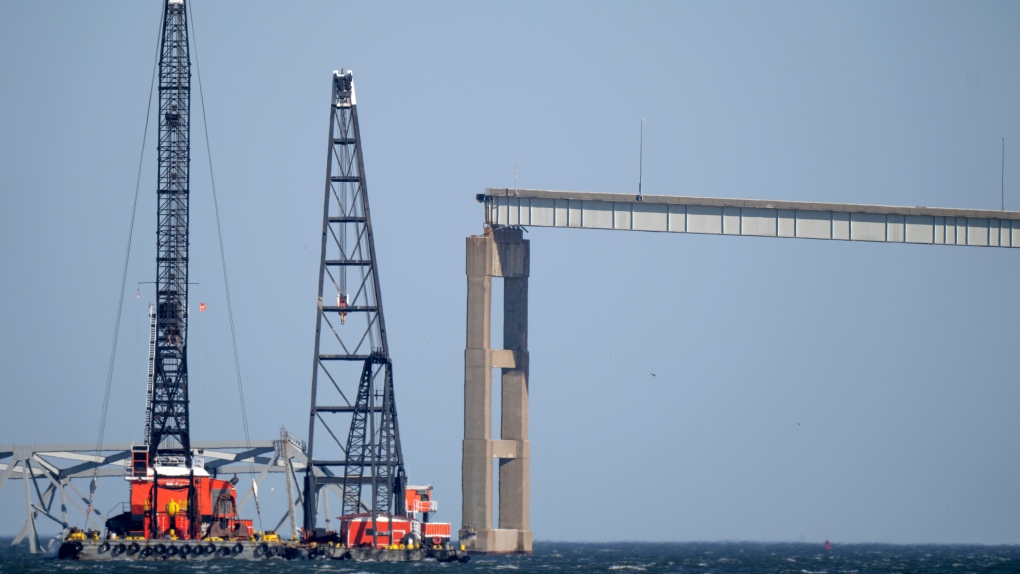At collapsed Baltimore bridge, focus shifts to the weighty job of removing the massive structure

Baltimore, Md. –
Teams of engineers are now focused on the formidable job of hauling the shattered remains of the Francis Scott Key Bridge out of Maryland’s Patapsco River, the first step toward reopening the Port of Baltimore and recovering the bodies of four workers who are still missing and presumed dead.
A massive cargo go ship felled the span Tuesday after striking one of its main supports. Experts are trying to figure out how to “break that bridge up into the right-sized pieces that we can lift,” U.S. Coast Guard Rear Adm. Shannon Gilreath said Friday at a news conference.
The tools that are needed have been coming into place. They include seven floating cranes — one of which is one of the largest on the Eastern Seaboard, capable of lifting 1,000 tons — 10 tugboats, nine barges, eight salvage vessels and five Coast Guard boats.
“To go out there and see it up close, you realize just how daunting a task this is,” Gov. Wes Moore said Friday afternoon as the massive crane loomed behind him.
“With a salvage operation this complex — and frankly with a salvation operation this unprecedented — you need to plan for every single moment,” Moore added.
Moore surveyed the scene and saw shipping containers ripped apart “like papier-mache.” The broken pieces of the bridge, including its steel trusses, weigh as much as 4,000 tons.
The wreckage has blocked ships from entering or leaving the vital port and also stymied the search for the missing workers.
“We have to bring a sense of closure to these families,” Moore said.
Moore also spoke of the disaster’s severe economic impact, saying, “What we’re talking about today is not just about Maryland’s economy; this is about the nation’s economy. The port handles more cars and more farm equipment than any other port in this country.”
Maryland’s Department of Transportation is already planning for rebuilding of the span and “considering innovative design, engineering and building methods so that we can quickly deliver this project,” Secretary Paul J. Wiedefeld said.
Adam Ortiz, the Environmental Protection Agency’s mid-Atlantic Regional Administrator, said there was no indication in the water of active releases from the ship or materials hazardous to human health.
Col. Roland L. Butler Jr., superintendent of the Maryland State Police, said the Federal Aviation Administration has been asked to establish a flight restriction area that would begin three nautical miles in every direction from the bridge’s center span and extend upward to 1,500 feet.
Butler advised people to keep drones away and said law enforcement is poised to act on any violations of that airspace.
The victims, members of a crew fixing potholes on the span when it was destroyed, were from Mexico, Guatemala, Honduras and El Salvador, officials said. At least eight people initially went into the water when the ship struck the bridge column, and two of them were rescued.
Divers then recovered the bodies of two men from a pickup truck in the river, but the nature and placement of the debris has complicated efforts to find the other four workers, as have the murky water conditions.
“The divers can put their hands on that faceplate, and they can’t even see their hands,” said Donald Gibbons, an instructor with Eastern Atlantic States Carpenters Technical Centers. “So we say zero visibility. It’s very similar to locking yourself in a dark closet on a dark night and really not being able to see anything.”
Baltimoreans made morning stops at vantage points Friday to watch for the cranes. Among them was Ronald Hawkins, 71, who used to be able to see the bridge from his home and recalled watching its construction in the 1970s.
“I’m going to come up here every day, because I want to see the bridge coming up out of the water,” Hawkins said. “It’s a hurtin’ thing.”
U.S. President Joe Biden’s administration has approved US$60 million in immediate aid, and Biden has said the federal government will pay the full cost of rebuilding the bridge, which was completed in 1977 and carried Interstate 695.
Ship traffic at the Port of Baltimore remains suspended, but the Maryland Port Administration said in a statement Friday that trucks were still being processed at marine terminals.
Federal and state officials have said the collision and collapse appeared to be an accident that came after the ship lost power. Investigators are still trying to determine why.
The crash caused the bridge to break and fall into the water within seconds. Authorities had just enough time to stop vehicle traffic but were unable to alert the construction crew.
The cargo ship Dali, which is managed by Synergy Marine Group, had been headed from Baltimore to Sri Lanka. It is owned by Grace Ocean Private Ltd. and was chartered by Danish shipping giant Maersk.
The loss of a road that carried 30,000 vehicles a day and the port disruption will affect not only thousands of dockworkers and commuters, but also U.S. consumers, who are likely to feel the impact of shipping delays.
Scott Cowan, president of the International Longshoremen’s Association Local 333, said the union was scrambling to help its roughly 2,400 members whose jobs are at risk of drying up.
“If there’s no ships, there’s no work,” he said. “We’re doing everything we can.”
Associated Press writers Sarah Brumfield in Washington, Kristin M. Hall in Nashville, Tennessee, Adrian Sainz in Memphis, Tennessee, and Lisa Baumann in Bellingham, Washington, contributed to this report.
View original article here Source









